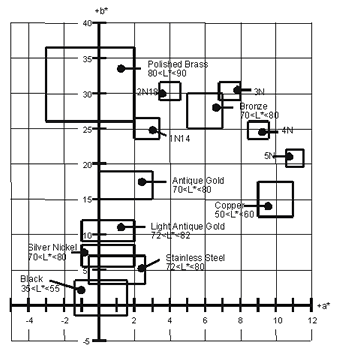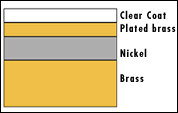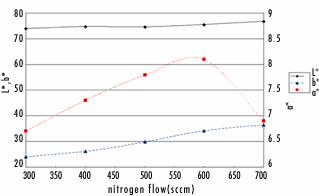Reproducible Decorative PVD Coatings
Anytime and anywhere, PVD coatings on brass, zinc, stainless steel and ABS plastic can be reproduced...
Since the mid-90’s, physical vapor deposition (PVD) coatings have been established as the high quality finish for sanitary and door hardware in the U.S. Major American OEM’s such as Baldwin, Delta, Kohler, Moen, Price Pfister and Schlage Lock are marketing these products with long-time guarantees on their appearance. Moen received the 2000 ASM Engineering Materials Achievement Award for its development of PVD coatings on its faucet lines.
PVD is a vacuum deposition technique where metal is vaporized in an atmosphere that consists of partly ionized noble or reactive gases. In the first case, a metallic layer is grown on the substrate material. In the second case, the metal reacts with the ionized gas, leading to a ceramic material. PVD ceramic coatings offer an alterative to traditional electroplating because of several characteristics: high hardness and wear resistance, no discoloration or tarnishing, high corrosion resistance and no attack by UV radiation
Originally, chromium colored faucets and doorknobs were made of brass or zinc and subsequently electroplated with a nickel/chromium finish for leveling, high luster and corrosion resistance. Trends in recent years show that increasingly more products are made of lower cost materials like ABS plastic. These trends have not only led to challenges for the electroplating companies but also for the manufacturers of PVD equipment.
At Hauzer, Venlo, the Netherlands, engineers have taken on this challenge and proven that all these substrate materials can be treated in a reproducible manner.
Limitations of electroplated brass
In the U.S., polished brass is the most popular color in sanitary and door hardware applications. Electroplating is the typical method for applying brass finishes. A nickel layer is deposited followed by a brass layer. To provide a corrosion barrier for the brass, the product is covered with a clear coat; however, because the clear coat is soft and attacked by UV light, the clear coat does not provide long-lasting protection.
Limitations of PVD
PVD coatings have no leveling effect, since it is a line-of-sight process. Also, the PVD cost is still high enough that the thickness is a cost-determining factor. The thickness of decorative PVD coatings is generally the range of 0.3 mm. At this thickness, a PVD coating does not act as a corrosion barrier; therefore, usually applied on top of electroplated products. With the PVD coating as the final step in the finishing cycle, the previous steps play an important role in end product quality. In this respect, a distinction has to be made between different substrate material, such as brass, zinc die-cast and ABS. Stainless steel as a substrate material does not need to be electroplated and can be coated together with brass and zinc products.
Pre-PVD Plating
The typical electroplating layers deposited to provide corrosion resistance and leveling consist of a nickel layer and chromium layer, sometimes on top of a copper layer. If these layers are used as a substrate for PVD coating, some features become more important.
Zinc die-cast. After a zinc die-casting process, the surface of the material may be rather rough. If the copper film does not adhere to the zinc over the entire surface, it will leave voids under the electroplated layers. During the PVD process, the products will be heated under vacuum, and entrapped gas will expand. The PVD coatings will adhere to the electroplated layers, but so called blisters will form. If the electroplating is too thin, entrapped gas may escape and the coating stack may “implode.”
ABS plastic. For PVD processes, it is preferable to have the complete ABS surface covered by a metal film. This coverage enables more flexibility in fixture design (electrically conductive contact between fixture and product is necessary) and reduced outgassing of the plastic material during the deposition process.
Cleaning Prior to PVD Coating
A sometimes-underestimated part of the production cycle is the precleaning of products prior to PVD coating. Part of the PVD process itself is an etching step; however, this is mainly meant as a finishing touch to ensure a perfect adhesion. The technology most used in precleaning is ultrasonic alkaline cleaning.
A typical cleaning line consists of baths with water-based alkaline cleaning agents, rinsing baths with city water, RO water and DI water and a vacuum or hot-air drying station. Care must be taken so that no silicon containing buffing compounds are left in or on the products when entering the cleaning line. The cleaning line must have sufficient flexibility to ensure appropriate cleaning of all substrate materials. Agents used for brass may not be suitable for zinc. The DI water in the rinsing baths has to be good enough to ensure no drying stains will form on the products. Last, the drying station has to be adjustable to enable good drying of low- and high-temperature resistant materials.
PVD Coating Process and Properties
As mentioned, the benefits of PVD coatings include high hardness and wear resistance, and no discoloration or tarnishing. These qualities depend on the parameters in the PVD process. One of the most important factors in determining the density of the coating and, therefore, the hardness and wear resistance of the coating, is the deposition temperature. The density of the coating improves with higher temperatures; however, the temperature resistance of the substrate material limits the process temperature. For PVD processes, the energy transfer to the film by radiant heating can partly be replaced by ion bombardment of the growing film.
With increased ion bombardment, the density of the coating increases (less porosity). Due to the larger compressive stress in the film, its hardness will also be larger. This means that the coatings will have a better wear resistance (higher hardness) and corrosion resistance (less porosity).
In this respect, it is necessary to make a distinction between two PVD technologies: arc evaporation and sputtering. With sputtering processes, the ionization level of the metal is limited to approximately 5%. In arc evaporation, the metal will pass through a very strong electron beam, leading to ionization levels of 90% or higher. The bombardment is even stronger because the average ionization is close to two.
By applying a negative potential to the substrates, these positively charged ions are accelerated toward the products, leading to the necessary ion bombardment of the growing film.
As the energetic bombardment in arc evaporation processes is 35 times higher than during sputtering, arc evaporation is the favorable deposition technology for low-temperature materials like ABS plastics. Decorative PVD coating chambers are mostly equipped with arc evaporation cathodes. Figure 2 shows a schematic top view of a decorative PVD installation.
The system has up to six cathode positions, which can hold both arc evaporation and magnetron sputtering cathodes. Target materials can be chosen freely, enabling production of multi-layers and metal compound coatings. For extended water vapor pumping speed, the system is equipped with fast cycle cryo panels. Products are mounted on fixtures with two- or three-fold rotation to ensure optimal coating uniformity. With a volume of approximately three sq meters and a locating height of two meters, the system is ideal for mass production of consumer goods as low cost per piece.
Because the temperature resistance of several substrate materials is limited, coatings with identical colors and high quality have to be produced at economically attractive prices. The standard PVD process for electroplated brass products typically consists of the following steps:
- Heating and pumping. With infrared heaters, the products are heated to their process temperature to ensure degassing has been reduced to an acceptable level prior to the actual deposition steps. With a combination of forevacuum1 pumps and turbo molecular pumps, the system is pumped down to a vacuum level sufficiently low enough to avoid negative effects on the coating quality. Special heat-up stations have been designed to preheat the substrate table, fixtures and products outside the vacuum chamber to reduce the cycle time.
- Target cleaning. The arc cathode is started with closed shutters in front of the targets to ensure a clean target surface at the beginning of the next process steps.
- Ion etching. The negative bias voltage accelerates metal ions from the arc materiala critical step for excellent adhesion.
-
Deposition. By choosing among other target material, arc current, bias voltage and gas flow of several gases, coatings of different compositions and structures are produced.
Processes Specific for Substrate Materials
Zinc die-cast. The combined quality of zinc die-castings and electroplating determines the temperature resistance of the products (between 80-180C). When the temperature limitation is known, the process settings for preheating, pumping and heating and ion etching steps can be tuned to prevent overheating. High quality electroplated zinc die-cast can be coated at similar temperatures to brass.
ABS plastic. In addition to temperature limitations, another problem of ABS plastic is its porosity and tendency to adsorb high amounts of water vapor. Degassing cannot be forced by heating the products to high temperatures; therefore, it has to be controlled in the vacuum chamber itself. With the normal vacuum pumps having low pumping speeds for water vapor, it takes a long time to pump down an installation to its necessary vacuum level. With the introduction of fast cycle cryo panels, the amount of time needed to pump down to a base pressure of 3E-mbar is reduced to approximately 15 minutes.
Stainless steel panels with tubing soldered to the back are mounted within the vacuum chamber. Water vapor in the chamber is adsorbed and trapped by a cooling medium with temperatures down to 150 Kelvin. In this way, the pumping speed for water vapor is increased immensely, and cycle times can be reduced to similar levels as for metal substrates. An extra benefit from the cryo panels is additional cooling for the products, opening a larger process window for heating and quality improvement by ion bombardment.
PVD Colors
PVD coatings can be produced in a wide color range. Several target materials can be chosen as long as they are conductive for arc evaporation technology. Metals used as target material in decorative PVD processes are zirconium, titanium, chromium, titanium-aluminum alloys and niobium. With the multi-target system, it is also possible to make compound coatings from more than one metal.
Ceramic coatings are made to increase the hardness and color window of the deposits. Introducing reactive gases during the deposition produces these hard coatings. The most used reactive gases are nitrogen and methane or acetylene to produce metal-nitride, metal-carbide and metal-carbonitride films. Sometimes oxygen is also used to produce oxides, oxinitrides, etc. These metals can be produced in a certain color range, depending on the metal-to-gas ratio in the film (also called stoichiometry) and the structure of the coating.
To change the stoichiometry and structure of the coating and its color, arc evaporation current, bias voltage, gas flow and temperature can be used: arc evaporation current, bias voltage, gas flow, temperature.
The process temperature affects the density and structure of the coating and, therefore, its color. This means that even with identical currents, bias voltages and gas flows, color difference will exist between products coated at different temperatures. With the goal to coat different substrate materials with identical colors in mind, other process parameters have to be found to counterbalance the effect of temperature. The effects of arc evaporation current, bias voltage, argon, nitrogen and acetylene flow have been examined in detail. Figure 3 shows the influence of the nitrogen flow on the color of zirconium-carbonitride coatings for a certain combination of evaporation current, argon and acetylene flow. Colors are measured in CIE-L*a*b* values.2
Zirconium is the most used target material for decorative applications in sanitary and door hardware because of its relatively wide color range.
Process Control
The process parameters for each collating (color) are stored in recipes with different process steps. During the process, all relevant process parameters are continuously monitored and controlled by an automatic control system. By storing the relevant parameters in recipes and controlling and monitoring them during the processes, it is possible to have an excellent reproducibility of the coating quality. PVD yields up to 98% have been achieved on a long-term basis.
The combination of these, specially designed installations with high flexibility and reliability and automatically controlled processes enable excellent reproducibility of a magnitude of colors on different substrate materials in multiple machines worldwide at any moment in time. Faucets assembled of brass, zinc and ABS products will show no color deviation, even if the substrate materials are purchased, electroplated and PVD coated in different locations.
Related Content
Vapor Degreasing Cleaning Fluids for Precision Cleaning
Tergo XCF2 cleaning solution is designed to meet diverse industrial technical cleaning needs with formulas that deliver reliable and repeatable cleaning performance.
Read MoreReplacing Open-Top Vapor Degreasing in Aerospace Manufacturing
Options and considerations for cleaning aerospace parts as regulations tighten on vapor degreasing solvents.
Read MoreVacuum Degreaser Cleans Up a Messy Situation
By replacing its immersion parts washer with a vacuum degreasing system, this machine shop is much more efficient, saving the company money, man hours and the health of the operators.
Read MoreUnderstanding Robotic Vacuum Impregnation
Robotic vacuum impregnation can be used to seal porosity, minimize scrap, increase throughput and reduce costs.
Read MoreRead Next
Education Bringing Cleaning to Machining
Debuting new speakers and cleaning technology content during this half-day workshop co-located with IMTS 2024.
Read MoreDelivering Increased Benefits to Greenhouse Films
Baystar's Borstar technology is helping customers deliver better, more reliable production methods to greenhouse agriculture.
Read MoreEpisode 45: An Interview with Chandler Mancuso, MacDermid Envio Solutions
Chandler Mancuso, technical director with MacDermid Envio discusses updating your wastewater treatment system and implementing materials recycling solutions to increase efficiencies, control costs and reduce environmental impact.
Read More

























